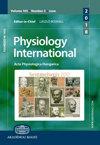The effectiveness of an mHealth intervention on diabetes risk factors and body composition
IF 2.2
4区 医学
Q3 PHYSIOLOGY
引用次数: 0
Abstract
Abstract Early identification and lifestyle intervention is beneficial for people with risk for diabetes. The aim of this study was to evaluate the risk of type 2 diabetes (T2D) in healthy overweight or obese women using the FINDRISC score and a twelve-week long mobile app-based lifestyle intervention. Fifty-four subjects were involved and forty-eight were analysed, n = 28 in the intervention group (online group: OG) and n = 20 in the control group (CG). Body composition was assessed using the InBody 720 device and diabetes risk was evaluated with the Finnish Diabetes Risk Questionnaire. The calorie intake and macronutrients were evaluated by a 3-day diary. Group differences and pre- and post-results were analysed using student t -tests by TIBCO Statistica 13.40.14. Significantly decreased body mass index (28.0 ± 2.5 kg m −2 vs 25.8 ± 4.3 kg m −2 , P = 0.00), body fat percentage (37.5 ± 6.3% vs 34.1 ± 5.9%, P = 0.03), waist circumference (100.8 ± 7.2 cm vs 94.7 ± 8.2 cm, P = 0.00) and visceral fat (124.0 ± 29.2 cm³ vs 109.0 ± 24.6 cm³, P = 0.04) were found in the OG. By the end of the programme, both groups showed significant decrease in food consumption, daily calorie intake (OG: 2,348.6 ± 348.0 vs 1,483.1 ± 114.4, CG: 2,372.4 ± 464.2 vs 1,654.1 ± 201.3 kcal day −1 , P = 0.00), fibre (OG: 19.5 ± 3.7 vs 26.1 ± 3.4, CG: 17.8 ± 3.9 vs 22.0 ± 4.8 g day −1 , P = 0.00) and cholesterol consumption (OG: 365.2 ± 58.9 vs 266.2 ± 65.8, CG: 377.4 ± 72.1 vs 269.2 ± 42.7 mg day −1 , P = 0.00). OG had a more significant reduction in body mass index ( P = 0.03) and body fat percentage ( P = 0.04) values at the end of the programme compared to the control group. In this study, it was found that mHealth intervention is a useful and effective method in the Hungarian female population. Further studies are needed to investigate modifications of this intervention to achieve more health-related effects.移动健康干预对糖尿病危险因素和身体成分的有效性
早期识别和生活方式干预对糖尿病高危人群有益。本研究的目的是利用FINDRISC评分和为期12周的基于移动应用程序的生活方式干预来评估健康超重或肥胖女性患2型糖尿病(T2D)的风险。共纳入54名受试者,对48名受试者进行分析,干预组(在线组:OG) n = 28,对照组(CG) n = 20。使用InBody 720装置评估身体成分,使用芬兰糖尿病风险问卷评估糖尿病风险。通过3天日记评估卡路里摄入量和常量营养素。采用TIBCO Statistica 13.40.14的学生t检验分析组间差异及前后结果。体重指数(28.0±2.5 kg m−2 vs 25.8±4.3 kg m−2,P = 0.00)、体脂率(37.5±6.3% vs 34.1±5.9%,P = 0.03)、腰围(100.8±7.2 cm vs 94.7±8.2 cm, P = 0.00)和内脏脂肪(124.0±29.2 cm³vs 109.0±24.6 cm³,P = 0.04)均显著降低。这个项目年底前,两组显示,食品消费显著下降,每日卡路里摄入量(OG: 2348。6 vs 1483。1±348.0±114.4,CG: 2372±464.2 vs 1654。1±201.3千卡−1天,P = 0.00),纤维(OG: 19.5±3.7 vs 26.1±3.4,CG: 17.8±3.9 vs 22.0±4.8克−1天,P = 0.00)和胆固醇消费(OG: 365.2±58.9 vs 266.2±65.8,CG: 377.4±72.1 vs 269.2±42.7毫克−1天,P = 0.00)。与对照组相比,OG组在项目结束时体重指数(P = 0.03)和体脂率(P = 0.04)值的降低更为显著。在这项研究中,发现移动健康干预是匈牙利女性人群中有用和有效的方法。需要进一步的研究来调查这种干预措施的修改,以获得更多与健康相关的效果。
本文章由计算机程序翻译,如有差异,请以英文原文为准。
求助全文
约1分钟内获得全文
求助全文
来源期刊

Physiology international
Medicine-Physiology (medical)
CiteScore
3.40
自引率
0.00%
发文量
37
期刊介绍:
The journal provides a forum for important new research papers written by eminent scientists on experimental medical sciences. Papers reporting on both original work and review articles in the fields of basic and clinical physiology, pathophysiology (from the subcellular organization level up to the oranizmic one), as well as related disciplines, including history of physiological sciences, are accepted.
 求助内容:
求助内容: 应助结果提醒方式:
应助结果提醒方式:


